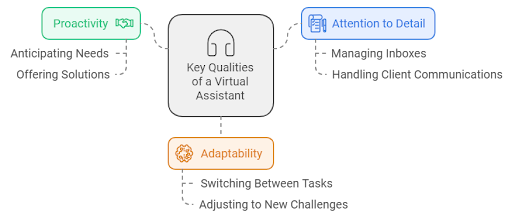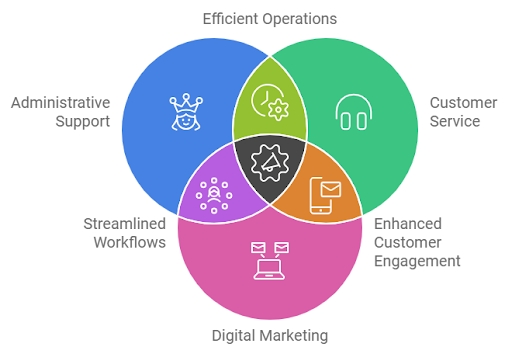
In recent years, remote work has transformed from an optional benefit to a necessity for businesses worldwide. As organizations adapt to new ways of operating, the role of virtual assistants (VAs) has become increasingly crucial. Virtual assistants offer valuable support, allowing companies to stay efficient and scalable without the overhead associated with traditional employees. However, successfully integrating virtual assistants into your remote work strategy requires planning, the right tools, and an understanding of best practices.
The Rise of Remote Work
The global shift toward remote work has been significant, with businesses embracing this model more than ever before. The COVID-19 pandemic accelerated this trend, with companies recognizing the benefits of remote operations, including cost reduction, increased flexibility, and access to a global talent pool.
Historical Context of Remote Work
While the idea of remote work may seem modern, it has been evolving for decades. Initially associated with freelancers and technology professionals, remote work has since expanded across various industries. Thanks to technological advancements like high-speed internet and cloud computing, employees can now work from anywhere in the world without sacrificing productivity.
Post-Pandemic Effects on Business Structures
The pandemic forced businesses to adapt quickly, proving that remote work is not only feasible but, in many cases, beneficial. In fact, studies suggest that a permanent shift toward remote work is here to stay. According to a Buffer survey, 97% of remote workers expressed a preference to work remotely for the rest of their careers.
The transition has also revealed that, for remote work to be sustainable, businesses need additional support in the form of virtual assistants, who help manage workloads and keep operations running smoothly.
The New Normal: Why Remote Work is Here to Stay
Many industries that previously relied on in-office staff, such as technology, marketing, and customer service, have found remote work not only viable but beneficial. The cost savings on physical office space, utilities, and equipment alone have been a major driving force behind this shift. Additionally, remote work has been shown to increase employee satisfaction and retention, leading to a more motivated workforce.
Remote Work Challenges that Virtual Assistants Solve
However, remote work isn’t without its challenges. Issues such as maintaining productivity, staying organized, and communicating effectively across time zones can hinder a team’s performance. This is where virtual assistants come in. By outsourcing routine tasks, companies can reduce the burden on their internal teams and keep operations running smoothly.
The Role of Virtual Assistants in Modern Remote Work Environments
A virtual assistant (VA) is a remote professional who provides administrative, technical, or creative assistance to businesses. These assistants handle a wide range of tasks, making them indispensable for companies operating in a remote work environment.
Virtual assistants have long been utilized by entrepreneurs and small business owners, but now companies of all sizes are realizing their value. As remote work continues to rise, the demand for virtual assistant services has skyrocketed. In fact, a recent survey by Upwork found that 35% of businesses are actively looking to hire virtual assistants to manage their remote workforces.
What Virtual Assistants Do
The roles of virtual assistants have expanded significantly, offering support across multiple areas:
- Administrative tasks: Scheduling, email management, and calendar organization
- Customer service: Answering queries, managing feedback, and providing support
- Marketing support: Social media management, content creation, and email marketing
- Technical support: Website maintenance, troubleshooting, and basic IT tasks
- Research and data entry
VAs are no longer limited to traditional secretarial duties. Today, they play a vital role in keeping businesses organized, efficient, and capable of scaling.
Benefits of Integrating Virtual Assistants
Integrating virtual assistants into your business model offers several key advantages:
- Cost Efficiency: VAs work remotely, so there are no overhead costs like office space or equipment.
- Flexibility: Virtual assistants provide scalable solutions to meet the evolving needs of a business.
- Global Talent Pool: Hiring virtual assistants allows companies to access the best talent, regardless of location.
- Time Savings: Delegating routine tasks allows business leaders to focus on more strategic operations.
How Virtual Assistants Provide Value Across Industries
Virtual assistants are no longer limited to administrative tasks. Today, they support a wide range of functions across industries, including:
- E-commerce: Virtual assistants handle customer inquiries, manage online storefronts, and oversee logistics.
- Healthcare: VAs in this sector manage appointments, handle patient follow-ups, and support billing processes.
- Marketing: From social media management to content creation, VAs play a crucial role in building a company’s online presence.
- Real Estate: Virtual assistants coordinate property listings, handle client communications, and even assist with marketing campaigns.
By utilizing virtual assistants, businesses can focus their core staff on more strategic initiatives, knowing that the day-to-day tasks are being handled by competent remote professionals.
Best Practices for Successfully Integrating Virtual Assistants into Your Remote Work Strategy

For companies looking to incorporate virtual assistants into their remote work strategy, the key to success lies in careful planning and management. It’s not enough to simply hire a VA; you need to ensure they are properly integrated into your workflow and provided with the tools and support necessary to succeed.
Step-by-Step Guide to Onboarding a Virtual Assistant
The onboarding process for a virtual assistant is slightly different from that of an in-house employee, but it is just as important. Here’s a step-by-step approach:
Setting Clear Expectations and Roles
Before hiring a virtual assistant, it’s critical to outline what tasks they will be responsible for. Having clear job descriptions and expectations ensures that both parties are aligned from the beginning. Be explicit about work hours, deadlines, and the tools they’ll need to use. Clarity reduces confusion and helps build a smooth working relationship.
Communication and Collaboration Tools
Effective communication is the backbone of successful remote work. Make sure that your virtual assistants have access to all the necessary collaboration tools. Platforms like Slack, Zoom, and Microsoft Teams make it easy to stay in touch, conduct meetings, and share updates.
Additionally, using project management tools like Asana, Trello, or ClickUp can help ensure that tasks are completed on time and that everyone is on the same page. These tools provide transparency and help you track the progress of your assistant’s work.
Managing Productivity and Deadlines
Managing remote workers can be challenging, especially if they are in different time zones. Set clear deadlines for tasks and use time tracking tools like Toggl or RescueTime to ensure accountability. Regular check-ins via email or video conferencing can also help maintain productivity.
Training and Onboarding
Even though virtual assistants are experienced professionals, it’s important to provide training that is specific to your business. This might include learning your company’s communication style, understanding your brand guidelines, or using proprietary tools. A thorough onboarding process ensures your assistant can hit the ground running.
Communication and Collaboration Tools
Maintaining clear communication is crucial when working remotely, especially with virtual assistants. Here are some tools that can help streamline communication:
- Slack: For real-time communication and team collaboration.
- Zoom: For virtual meetings, face-to-face communication, and webinars.
- Microsoft Teams: A comprehensive platform for chats, video calls, and document sharing.
In addition to regular check-ins, documenting workflows and using Standard Operating Procedures (SOPs) can minimize confusion and provide VAs with clear guidelines for their responsibilities.
Managing Productivity and Deadlines
One of the challenges of working remotely is managing productivity. Set clear expectations for deliverables and deadlines, and use time-tracking tools such as Toggl or RescueTime to ensure tasks are completed on time. Regular meetings or weekly check-ins via email or video conferencing also help maintain productivity and accountability.
Must-Have Tools and Technology to Maximize Efficiency with Virtual Assistants
A well-integrated virtual assistant relies on the right tools to stay productive and connected. These tools not only help the VA perform their tasks but also ensure that the entire team stays organized and efficient. Below is a more detailed exploration of the tools that can optimize the relationship between your business and your virtual assistant.
Project Management Tools
Project management tools provide transparency into a virtual assistant’s tasks and deadlines. The following tools are essential:
- Asana: A user-friendly project management platform that allows teams to assign tasks and track progress.
- Trello: Known for its visual boards, Trello is perfect for managing tasks with ease.
- ClickUp: An all-in-one project management tool offering advanced features for teams of all sizes.
These platforms enable businesses to manage projects seamlessly, ensuring that VAs stay on task and meet deadlines.
Communication Platforms
Effective communication is vital to the success of any remote team. Here are some of the top platforms used by remote teams:
- Slack: A popular messaging app that simplifies team communication and collaboration.
- Zoom: Ideal for video conferencing, screen sharing, and remote team meetings.
- Microsoft Teams: A versatile platform that integrates messaging, video conferencing, and document sharing.
Time Tracking and Productivity Tools
Tracking productivity is essential when working with virtual assistants. Use the following tools to ensure tasks are completed efficiently:
- Toggl: A time-tracking app that helps both employees and employers understand how time is being spent on various tasks.
- RescueTime: A productivity tracking tool that provides insights into how time is being used across different activities.
File Sharing and Collaboration Tools
Seamless file sharing is critical for remote teams. Popular tools include:
- Google Workspace: A cloud-based platform that enables easy file storage, editing, and collaboration.
- Dropbox: A trusted file-sharing solution with cloud storage capabilities.
Security and Data Protection Tools
When working with virtual assistants, especially those handling sensitive information such as client data or financial records, security is paramount. Invest in robust security tools such as:
- VPNs (Virtual Private Networks): Ensure all online activities are encrypted.
- Password Managers: Tools like LastPass and 1Password allow for secure sharing of login credentials without exposing sensitive information.
- Cloud-based storage with encryption: Solutions like Box or OneDrive offer end-to-end encryption to protect your files.
These tools help ensure that documents, presentations, and other important files are easily accessible and secure, regardless of location.
Overcoming Common Challenges When Working with Virtual Assistants
While virtual assistants bring numerous advantages to the table, there are several challenges businesses must be prepared to navigate. Expanding on some of the common issues discussed previously, here’s a deeper look at solutions for overcoming these obstacles.
Time Zone Differences and Scheduling Conflicts
Time zone differences can complicate scheduling, especially for businesses that require real-time collaboration. Fortunately, these issues can be addressed with proper planning:
- Calendly: Automates meeting scheduling by allowing participants to choose from available times.
- World Time Buddy: Helps coordinate meetings across time zones.
Setting overlapping working hours where possible ensures that communication between teams is smooth and effective.
Another solution is to hire virtual assistants from time zones that overlap with your working hours. For example, businesses in Europe may consider hiring VAs from Singapore due to the relatively short time zone difference, making it easier to coordinate.
Cultural Differences and Communication Styles
Cultural nuances can sometimes impact how tasks are interpreted or how feedback is given. For example, direct communication styles common in Western countries may be seen as abrasive in other parts of the world. To bridge this gap, provide cultural sensitivity training for both your virtual assistants and your in-house team to foster a collaborative and respectful work environment.
Additionally, using clear and concise language in both verbal and written communications can prevent misunderstandings. It’s also helpful to avoid idioms or slang that might not be understood by someone from a different cultural background.
Performance Monitoring and Accountability
Monitoring the performance of a virtual assistant is challenging but essential. By establishing clear Key Performance Indicators (KPIs) and using project management and time-tracking tools, businesses can ensure accountability and high-quality performance. Regular feedback sessions are crucial for maintaining engagement and motivation.
How to Choose the Right Virtual Assistant for Your Business Needs

The process of selecting the right virtual assistant for your business goes beyond evaluating basic skills. To find the perfect fit, it’s essential to understand your long-term goals and the specific challenges you’re looking to address. This section delves deeper into the nuances of hiring a VA.
Skills Assessment
Before you begin the hiring process, make a list of the skills your business needs. For example, if you need help with marketing, look for a virtual assistant who has experience in social media management or email marketing. If you need administrative support, make sure the assistant is well-versed in data entry, email management, and calendar scheduling.
Freelance vs. Agency-Based Virtual Assistants
You can hire virtual assistants either as freelancers or through agencies. Freelancers tend to offer more flexibility and lower rates, while agency-based assistants come with built-in support and additional resources. Agencies like Avery Outsourcing ensure that virtual assistants are trained and equipped to handle a wide variety of tasks.
Interviewing and Evaluating Candidates
Once you’ve identified potential candidates, conduct interviews to assess their skills and cultural fit. Ask for samples of previous work, and consider setting up trial tasks to see how well they perform under real-world conditions.
Identifying Key Qualities in a Virtual Assistant
Look for virtual assistants who possess the following traits:
- Proactivity: A great virtual assistant anticipates needs and offers solutions without waiting for instructions.
- Attention to Detail: Whether managing your inbox or handling client communications, a good VA pays attention to the small things.
- Adaptability: The ability to switch between tasks and adjust to new challenges is critical, especially in fast-paced environments.
Trial Periods and Task-Specific Assessments
Before making a long-term commitment, many businesses find it beneficial to start with a trial period or task-specific assessment. This allows both parties to test the working relationship and ensure a good fit. During the trial period, assign tasks that reflect the core responsibilities of the VA’s role, and provide feedback regularly to gauge how well they adapt to your workflow.
The Benefits of Outsourcing Virtual Assistants in Singapore
Outsourcing virtual assistants in Singapore offers several advantages, particularly for businesses looking for high-quality, reliable talent. Singapore is a hub of business excellence, with a highly skilled workforce and a strong educational background. Here’s why Singapore stands out as an ideal destination for outsourcing.
Singapore’s Position as a Global Business Hub
Singapore is strategically located at the crossroads of global trade routes, making it an ideal location for businesses to outsource their operations. The country has a stable political climate, a transparent legal system, and a robust economy, providing a strong foundation for businesses looking for reliable virtual assistants.
High-Quality English Proficiency and Education
One of Singapore’s major strengths is its well-educated workforce, with a high proficiency in English. This makes it easier for companies to communicate effectively with their virtual assistants, reducing the likelihood of misunderstandings.
Time Zone Compatibility for Global Businesses
Singapore’s time zone (GMT+8) makes it a suitable option for businesses in both Asia and Western countries. Companies can hire VAs in Singapore to ensure coverage during key business hours.
Access to Specialized Talent
Singapore’s workforce is known for its high level of education, with a strong emphasis on technology and business skills. As a result, businesses looking to hire virtual assistants can find professionals with specialized expertise in areas such as:
- Finance and accounting
- Digital marketing and SEO
- Software development
- Legal assistance
Avery Outsourcing – Leading Virtual Assistant Agency in Singapore

If you’re looking for high-quality virtual assistant services in Singapore, Avery Outsourcing is a leader in providing top-tier talent to businesses worldwide. Avery is known for its rigorous hiring process, ensuring that only the best virtual assistants join their team.
What Sets Avery Outsourcing Apart?
Avery Outsourcing offers:
- Tailored Services: Every business has unique needs, and Avery ensures that their VAs are trained to meet those specific requirements.
- Continuous Training: Avery provides ongoing training to their virtual assistants, ensuring they stay updated on the latest tools and best practices.
- Dedicated Support: When you partner with Avery Outsourcing, you get a dedicated account manager who ensures the VA’s performance aligns with your goals.
Range of Services Offered by Avery Outsourcing
Avery Outsourcing offers a comprehensive range of services, including:
- Administrative support
- Customer service
- Digital marketing
- Technical support
- Content creation
How Avery Ensures Quality and Performance
Avery Outsourcing is committed to delivering high-quality virtual assistant services. They rigorously vet their assistants and provide ongoing training to ensure that they are up to date with the latest tools and technologies.
Future Trends in Remote Work and Virtual Assistant Integration
Looking forward, the role of virtual assistants will continue to evolve as new technologies and business models emerge. Here are a few trends shaping the future of the industry.
Virtual Assistants and the Growth of the Gig Economy
The gig economy is expected to grow exponentially in the coming years, with more professionals opting for freelance and contract-based roles. This shift will make it easier for businesses to find highly specialized virtual assistants who are looking for short-term, project-based work.
The Role of Artificial Intelligence in Virtual Assistant Services
As artificial intelligence (AI) continues to improve, it will take on more routine tasks, allowing virtual assistants to focus on more complex and value-added services. For instance, AI can automate calendar management or email filtering, enabling VAs to concentrate on tasks that require human insight and creativity.
Increased Demand for Specialized Virtual Assistants
As businesses become more sophisticated, there will be a growing demand for specialized virtual assistants with skills in areas like digital marketing, IT support, and legal services.
Supercharge Your Remote Workforce with Avery Outsourcing!
Ready to enhance your remote workforce? Avery Outsourcing provides the skills, support, and professionalism you need to take your business to the next level. Whether you’re looking for administrative assistance or specialized talent, our virtual assistants are here to help you succeed. Contact Avery Outsourcing today to learn more about how we can help your business grow.




